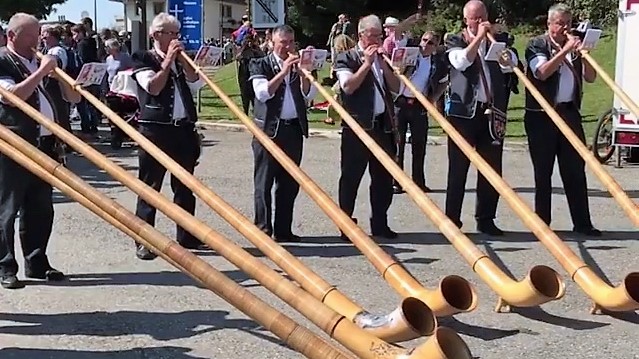
It’s late September, and Saturday morning in the tiny Swiss village of Charmey seemingly starts off as any other. Cafes open their doors, letting mouthwatering aromas of freshly-baked pastries waft into the open air. Shopkeepers sweep their cobblestone doorsteps, preparing for the day’s business. A small delivery truck putters by. Comme c’est Toujours.
It soon becomes apparent to me that this day will be different. Far more people are milling about than usual for a population of 2500, and they keep arriving. A constant flow of shuttle buses drops people off in the center of town, including me. Soon the streets are filled with activity. Everyone jostles for the best viewing spot on the sidewalk, and there’s excitement in the air. Something’s up!
A little after 9 am, a faint sound emerges. As the minutes pass, the volume increases— rising to a nearly cacophonous level. The slow rumble of a thousand hooves mixes with the clanging of brass and tin bells.
The bands play. The people cheer. The cows are going home.
I’m in the canton of Fribourg to experience one of many dèsalpes festivals taking place over the next few weeks, and Charmey boasts one of the best in the region. For the next eight hours or so a new herd will capture the crowd’s attention and applause every half-hour as they amble past us on Rue du Centre, making their way to an even smaller village somewhere down the road.
At the core of all the celebration and conviviality is the pastoral tradition of transhumance – the seasonal practice of moving livestock from one feeding ground to another. Written evidence of alpine transhumance dates back as far as the thirteenth century although it is thought to be thousands of years old. It continues today, virtually unchanged.
In Switzerland, nearly 130,000cows are escorted up the mountains to their alpine grazing grounds early each summer, a journey known locally as ‘La Poya’. (The tradition extends to another 200,000sheep in the region as well.) They will spend the next three months or so grazing on the grasses and wildflowers found only at these altitudes, producing milk for consumption and alpine cheese making.
As summer gives way to autumn, each herder begins to contemplate when to descend for the winter. While it may seem like a decision driven by weather, it is actually dependent on the availability of food for the animals. Because the Gruyère d’Alpage AOP does not allow the animals to consume any food not found in the mountains, close attention is paid to the condition of the grazing fields and slopes. When the supply runs low, it’s time to go.
Preparing for the descent is a colossal effort. Seasonal living quarters (often little more than a two or three room cottage) must be repaired and winterized, grazing fields tended to, and the animals themselves ready for a journey to a village that may take up to 9-10hours of walking.
While long and exhausting, the journey is also a cause for great celebration amongst the farmers. Everyone involved is dressed in their finest. For the humans, traditional sky-blue Edelweiss shirts, embroidered dresses, and ornate alpine smocks are worn. For the cows, gorgeous headdresses made from flowers are accompanied by hand-forged alpine bells draped over their necks on thick, intricately-decorated leather straps.
A cow’s status within the herd influences its decoration. Alpha animals and those of prominence are given larger bells, with the biggest measuring nearly two feet across. The floral arrangements are symbolic as well. The importance of the cheesemaker is traditionally recognized by allowing one cow per maker to wear a small, single-leg milking stool on their head for the journey. The stool is inverted and decorated with a floral tree.
For those not escorting livestock, the dèsalpe festival resembles a county fair. In the center of town, a side street has been turned into an outdoor marketplace. Kiosks line the walkway selling all sorts of food, drink, and crafts. I stop at a booth to buy a couple jars of raw alpine honey. I stop at another to get a heaping plate of rösti – a kind of potato fritter smothered in bacon and sauteed onions. (It’s just what I need to nibble on with my bottle of Vully Blanc, a refreshing white wine named for the village in Neuchâtel.)
Once all the herds have passed, the celebrations continue into the night. It’s easy for me to see why the dèsalpes festival is so popular. With all the food and drink and music and sunshine, what’s not to like? Beneath all the merrymaking, however, I saw a true appreciation for what was happening that day. Even if people didn’t know transhumance by name, they embraced what it represented. The cheers from the spectators were genuine. The smiles were authentic. What could have been just another excuse to tear it up on a Saturday was really a deep celebration of a revered Swiss tradition.






